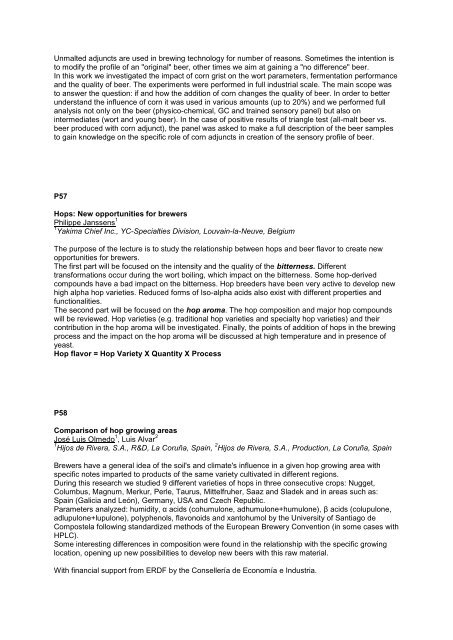here - the 34th European Brewery Convention
here - the 34th European Brewery Convention
here - the 34th European Brewery Convention
You also want an ePaper? Increase the reach of your titles
YUMPU automatically turns print PDFs into web optimized ePapers that Google loves.
Unmalted adjuncts are used in brewing technology for number of reasons. Sometimes <strong>the</strong> intention is<br />
to modify <strong>the</strong> profile of an "original" beer, o<strong>the</strong>r times we aim at gaining a "no difference" beer.<br />
In this work we investigated <strong>the</strong> impact of corn grist on <strong>the</strong> wort parameters, fermentation performance<br />
and <strong>the</strong> quality of beer. The experiments were performed in full industrial scale. The main scope was<br />
to answer <strong>the</strong> question: if and how <strong>the</strong> addition of corn changes <strong>the</strong> quality of beer. In order to better<br />
understand <strong>the</strong> influence of corn it was used in various amounts (up to 20%) and we performed full<br />
analysis not only on <strong>the</strong> beer (physico-chemical, GC and trained sensory panel) but also on<br />
intermediates (wort and young beer). In <strong>the</strong> case of positive results of triangle test (all-malt beer vs.<br />
beer produced with corn adjunct), <strong>the</strong> panel was asked to make a full description of <strong>the</strong> beer samples<br />
to gain knowledge on <strong>the</strong> specific role of corn adjuncts in creation of <strong>the</strong> sensory profile of beer.<br />
P57<br />
Hops: New opportunities for brewers<br />
Philippe Janssens 1<br />
1 Yakima Chief Inc., YC-Specialties Division, Louvain-la-Neuve, Belgium<br />
The purpose of <strong>the</strong> lecture is to study <strong>the</strong> relationship between hops and beer flavor to create new<br />
opportunities for brewers.<br />
The first part will be focused on <strong>the</strong> intensity and <strong>the</strong> quality of <strong>the</strong> bitterness. Different<br />
transformations occur during <strong>the</strong> wort boiling, which impact on <strong>the</strong> bitterness. Some hop-derived<br />
compounds have a bad impact on <strong>the</strong> bitterness. Hop breeders have been very active to develop new<br />
high alpha hop varieties. Reduced forms of Iso-alpha acids also exist with different properties and<br />
functionalities.<br />
The second part will be focused on <strong>the</strong> hop aroma. The hop composition and major hop compounds<br />
will be reviewed. Hop varieties (e.g. traditional hop varieties and specialty hop varieties) and <strong>the</strong>ir<br />
contribution in <strong>the</strong> hop aroma will be investigated. Finally, <strong>the</strong> points of addition of hops in <strong>the</strong> brewing<br />
process and <strong>the</strong> impact on <strong>the</strong> hop aroma will be discussed at high temperature and in presence of<br />
yeast.<br />
Hop flavor = Hop Variety X Quantity X Process<br />
P58<br />
Comparison of hop growing areas<br />
José Luis Olmedo 1 , Luis Alvar 2<br />
1 Hijos de Rivera, S.A., R&D, La Coruña, Spain, 2 Hijos de Rivera, S.A., Production, La Coruña, Spain<br />
Brewers have a general idea of <strong>the</strong> soil's and climate's influence in a given hop growing area with<br />
specific notes imparted to products of <strong>the</strong> same variety cultivated in different regions.<br />
During this research we studied 9 different varieties of hops in three consecutive crops: Nugget,<br />
Columbus, Magnum, Merkur, Perle, Taurus, Mittelfruher, Saaz and Sladek and in areas such as:<br />
Spain (Galicia and León), Germany, USA and Czech Republic.<br />
Parameters analyzed: humidity, α acids (cohumulone, adhumulone+humulone), β acids (colupulone,<br />
adlupulone+lupulone), polyphenols, flavonoids and xantohumol by <strong>the</strong> University of Santiago de<br />
Compostela following standardized methods of <strong>the</strong> <strong>European</strong> <strong>Brewery</strong> <strong>Convention</strong> (in some cases with<br />
HPLC).<br />
Some interesting differences in composition were found in <strong>the</strong> relationship with <strong>the</strong> specific growing<br />
location, opening up new possibilities to develop new beers with this raw material.<br />
With financial support from ERDF by <strong>the</strong> Consellería de Economía e Industria.





